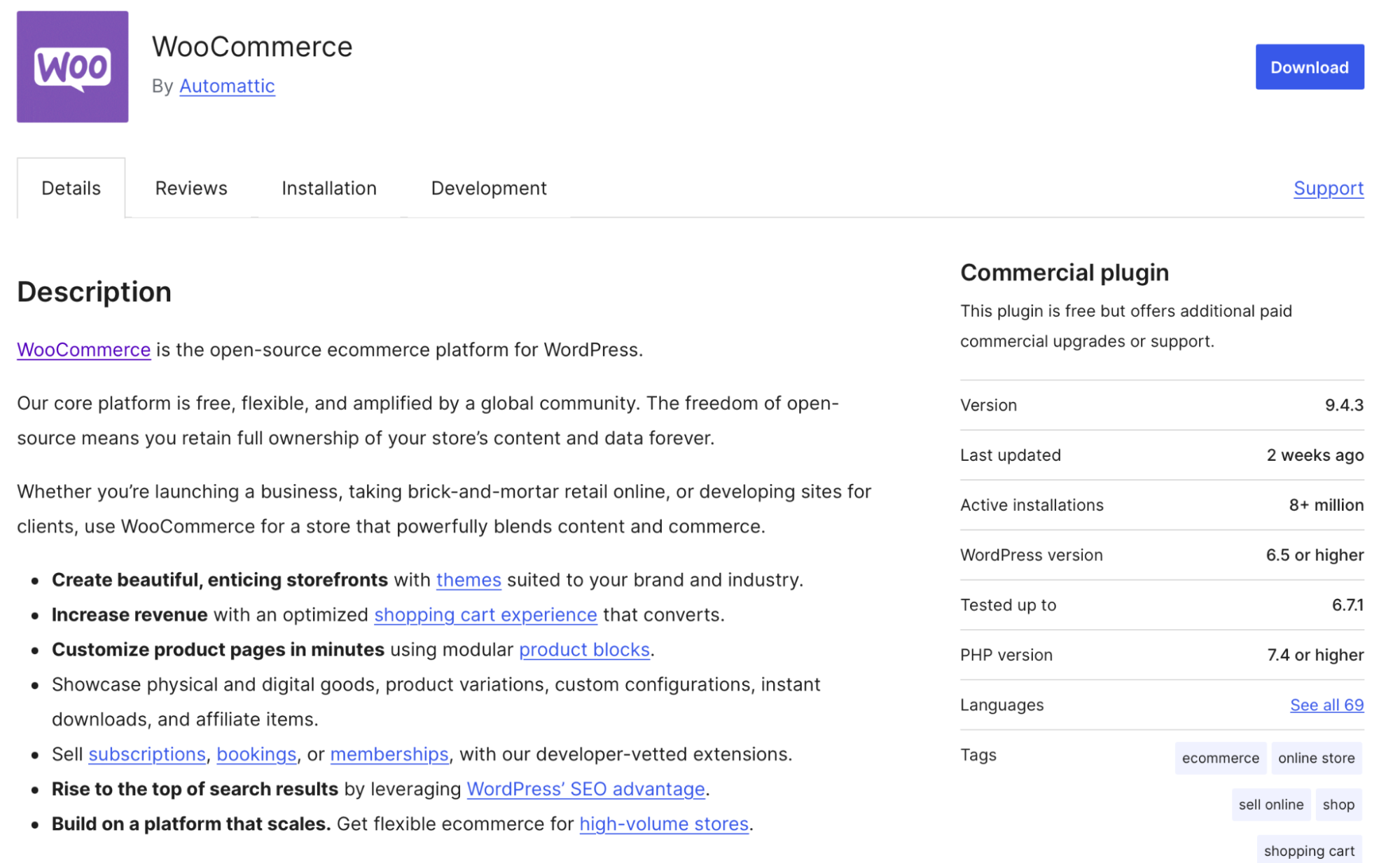Drive sales on autopilot with ecommerce-focused features
See FeaturesYou’re probably familiar with WooCommerce, one of the leading ecommerce plugin for WordPress. It allows you to set up an online shop and sell a variety of products, including physical items, subscriptions, and downloads. However, you might be wondering — is it worth the hype?
WooCommerce is free, open-source software that you can install on your WordPress website. It’s highly flexible, enabling you to design a custom store and integrate it with third-party services like marketing platforms. While this is great news for business owners, there can be quite a bit of work involved in setting up a fully-functional WooCommerce site.
In this post, we’ll take a closer look at WooCommerce and its popularity in the market. Then, we’ll dive into its pros and cons, and discuss how it stacks up against other ecommerce platforms. Let’s jump in!
Quick sign up | No credit card required
What is WooCommerce?
WooCommerce is an ecommerce plugin for WordPress that lets website owners sell products and services online. It’s owned by Automattic, the people behind WordPress.com.
Key features of WooCommerce include:
- Support for a wide array of product types, including physical and digital items, and grouped and variable products
- The ability to offer different shipping options for your customers
- Order management directly from your website
- Integrations for multiple payment methods including traditional debit and credit cards, digital wallets, and even crypto
- Extensions for many third-party tools, like email marketing platforms and print-on-demand services
While it’s possible to start right away with default, pre-built styles, WooCommerce is also very customizable. You can begin with a dedicated WooCommerce theme and edit the design to reflect your branding. When you install the plugin, you also get a set of WooCommerce blocks to customize your shop, including the product pages and checkout experience.
Plus, you can extend your store’s functionality with a vast selection of WooCommerce extensions. You’ll find options for selling subscriptions, accepting bookings, displaying testimonials, adding payment gateways, and much more.
How popular is WooCommerce?
WordPress powers over 43 percent of the internet, which makes it the most popular content management system (CMS) on the market. Meanwhile, the WordPress directory shows that WooCommerce has over eight million active installations, as you can see in the image below:

BuiltWith estimates this number to be closer to six million. In terms of market share, WooCommerce leads by a considerable amount, besting alternatives like Shopify and Wix. According to Store Leads, it’s used by 35 percent of all online shops.
WooCommerce isn’t the only option that WordPress users have for selling items online. There are other ecommerce plugins available, like Easy Digital Downloads. However, WooCommerce is miles ahead of the competition, powering over 93 percent of all WordPress ecommerce sites.
Pros of WooCommerce
To get a better picture of WooCommerce, let’s take a look at its advantages:
It offers maximum flexibility
You can use WooCommerce to sell physical goods, online courses, downloadable items, and many other types of products. It’s also the ideal plugin for setting up a dropshipping business or a subscription-based service.
There are WooCommerce extensions that enable you to partner with preferred shipment carriers, offer alternative payment methods (like Klarna), set up a rewards program or membership site, and more.
WooCommerce lets you modify the source code, so you can also make manual adjustments to your site without relying on extensions. Alternatively, you could hire a developer to create any custom functionality you need for your store.
It’s open-source software
WooCommerce is an open-source tool, which means that its source code is publicly accessible. This enables anyone to make custom modifications to the plugin. It also facilitates collaboration among various developers who want to contribute to the platform and make improvements.
In contrast, proprietary platforms like Wix and Shopify only allow the original developers to modify code. This lack of flexibility makes them unsuitable for building complex or custom websites.
With proprietary platforms, you’re also beholden to certain terms and conditions. If you break them, your site can be taken down immediately and all the work you’ve invested will be lost for good.
On the other hand, having a WooCommerce store means you retain full control and ownership of your content.
It’s affordable
The WooCommerce plugin is free. You can install it directly from your WordPress dashboard, or download it from the official website.
If you already have a WordPress site and you’re paying for hosting, there are no other costs involved. If not, don’t worry — there are plenty of hosting providers that offer affordable starter plans for WooCommerce sites.
With WooCommerce, you only pay for the extensions you need and many are available for free. And while you can choose a premium theme, there are many free themes and plugins available that are the right fit for many stores.
You might also need to pay a transaction fee to your payment provider when you sell a product, but this is true for all payment processors, no matter the platform you’re using. As you can see, WooCommerce pricing will depend on your choice of service providers and third-party integrations.
There’s a strong advantage here over other platforms, though, because you control the costs. For instance, you can switch hosting providers if the renewal fees are too high, change plugins, opt for a free theme, design everything yourself or hire an experienced agency. Everything is within your control.
It’s scalable
WooCommerce is powerful enough to support unlimited products and variations. The Woo team states that some sites built with the plugin have over 100,000 products and handle thousands of transactions per minute. There are also no limits on the number of registered users and customers on your website.
The Woo website itself is powered by WordPress and WooCommerce. This is a large-scale business that sells to customers all over the world, so it’s a convincing display of the plugin’s scalability.
So, if you’re looking to grow your store, WooCommerce is a safe option.
It’s easy to use
You don’t need technical expertise to set up and use WooCommerce. The plugin is designed for everyone, including complete beginners.
The setup wizard walks you through the process of launching your online store, as you can see here:

You’ll start by choosing a design for your store, adding your products, and configuring payment methods. If applicable, you’ll also set up tax rates and shipping options. Then, you’re ready to build!
WooCommerce integrates with the block editor and even comes with a set of handy blocks that you can add to any page on your site. They look like this:

For example, you have blocks for product filters, on-sale items, miniature carts, store notices, and many more.
All you have to do is place a block anywhere you want on the page, then use the available settings to configure its layout, color, and other options.
There’s a large, supportive community
Thanks to its popularity, WooCommerce has a large community of users and developers. You’ll find plenty of resources and forums that contain tutorials and other helpful information for shop owners.
The WooCommerce documentation is the best place for guides, tutorials, and technical information. There’s also a library of educational resources like webinars, videos, and online courses on the official WooCommerce site.
Meanwhile, the Woo Slack is ideal for developers and those looking to stay up-to-date with announcements, meetups, jobs, and other topics. On the WooCommerce GitHub repository, developers and site owners can share ideas, view code, report issues, and make other valuable contributions to the software.
You can also participate in local meetups and events like WordCamp, which bring together WordPress and WooCommerce users to learn and get to know one another. If you’re on Facebook, you can join the Woo Community private group.
You get full control
WooCommerce gives you full control over your store. You’ll be able to manage every aspect of your website, from design and functionality to backups and search engine optimization (SEO).
You’ll also have the freedom to implement measures to protect your site, like fraud protection tools, malware scanners, two-factor authentication, and more. You can even promote your business by integrating your WooCommerce store with email marketing platforms and social media.
There are lots of options for international stores
WooCommerce is ideal for international stores that need to accommodate a global audience.
When installing the plugin, you’ll need to select your currency. However, you can also use a currency switcher plugin so site visitors can see prices in their preferred currencies.
WooCommerce supports many popular payment gateways around the world. This enables you to build trust with customers and support the currencies and payment methods most common in the regions you serve.
You can find integrations for most major shipping carriers, and the official Woo team has a shipping extension that works with popular solutions like FedEx, USPS, UPS, and DHL. WooCommerce also lets you display shipping zones to show customers where you deliver. You can even set delivery prices for each zone.
Finally, you can easily translate your store using a plugin like Weglot. This enables you to cater to customers in different countries and expand your market.
Cons of WooCommerce
While WooCommerce is a powerful plugin, it also has some drawbacks. Let’s take a look at them:
There’s no live chat/ticketed support
One of the biggest drawbacks of using open-source software like WooCommerce is the lack of dedicated support.
With proprietary platforms, there’s usually a ticketing system that streamlines the process of contacting support agents. These solutions also offer a variety of support channels.
For instance, Shopify provides 24/7 live chat support while top-tier plans come with 24/7 priority phone support. This enables merchants to resolve issues quickly, minimizing downtime and revenue loss.
As we’ve seen, you can still find WooCommerce support and resources online. However, responses come from community members, rather than trained support staff.
Note that most WooCommerce extensions, particularly premium ones, do offer direct support. This includes extensions developed by the actual Woo team.
More control means more work
The high level of customizability and control that WooCommerce offers is also a potential drawback. While it enables you to achieve virtually anything for your online store, it also requires you to take on a greater share of responsibility.
In contrast, all-in-one ecommerce platforms like Wix and Shopify provide a more hands-off experience. These platforms deliver a complete package, handling critical website maintenance tasks like updates, backups, and security, so you can focus on growing your business.
With WooCommerce, these tasks fall to you. To keep your website secure and running smoothly, you’ll need to choose a reliable web host, optimize your site’s performance, create backups, update software regularly, and manage other technical aspects.
If you lack the skills to handle these responsibilities, there are options to simplify the process. You can leverage extensions that automate many of these tasks, or, if your budget allows, hire a developer, agency, or IT professional to take care of them for you.
Initial setup can take longer/be more tricky
Although WooCommerce is designed to be user-friendly, it can present challenges if you’re new to WordPress.
For instance, you might not know what a plugin is, or how to make regular backups. Educating yourself on how WordPress and WooCommerce work often requires time, effort, and hands-on experience.
The setup process can also be time-intensive, particularly if you’re doing everything manually. You’ll need to configure shipping options and tax rates, and upload your products one by one (unless you have all the data in a CSV file which you can import into WordPress).
Adding functionality introduces additional steps. Each desired feature — like payment gateways, SEO tools, or marketing integrations — requires finding the right extension, installing it, and configuring its settings.
This level of customization offers immense flexibility but also demands more effort.
By contrast, platforms like Shopify bundle features like web forms, subscriptions, and loyalty programs directly into their offerings, making them more convenient if you want to create your store with minimal input on your end.
How does WooCommerce compare to other platforms?
You might wonder how WooCommerce stacks up against other ecommerce platforms. Well, let’s compare it to its main competitors:
WooCommerce vs. Wix
Wix is a proprietary website builder that offers built-in tools and features right out of the box.
For beginners, Wix is a fantastic choice. Its intuitive drag-and-drop editor is often easier to navigate than the WordPress block editor, and the platform’s tools and dedicated customer support make for a hassle-free experience.
That said, you’ll be limited in terms of customization as you’ll have to work with the options provided by the company. This applies to some super important things — like SEO, payment gateways, and marketing features.
If you’re trying to decide between Wix and WooCommerce, remember that WooCommerce lets you edit the source code directly. Plus, WooCommerce supports a vast ecosystem of themes and plugins, so you can build a truly unique store tailored to your specific needs.
WooCommerce vs. Shopify
While Wix and Shopify are similar, the latter is better suited for building and scaling online businesses.
Like Wix, Shopify comes with pre-designed templates and built-in tools. It also integrates with more than 8,000 apps available in the Shopify Marketplace. This makes it somewhat extensible, but you don’t have as much freedom as you do with the WooCommerce platform.
A big difference between WooCommerce vs. Shopify is scalability. WooCommerce is ideal for businesses looking to grow, as it offers unlimited customization and flexibility without locking you into subscription tiers.
In contrast, Shopify requires you to upgrade your plan for features like additional support, more staff accounts, or increased inventory locations. While Shopify’s basic packages are affordable, costs can rise quickly for larger or more complex businesses.
Another factor to consider is platform migration. Shopify makes switching to another platform very challenging, so you’ll want to choose the right ecommerce solution from the start.
WooCommerce vs. OpenCart
Choosing between OpenCart and WooCommerce comes down to your website needs.
OpenCart is a standalone ecommerce platform that caters well to niche businesses. In contrast, WooCommerce is versatile and suitable for all types of online stores, from small startups to large-scale enterprises.
When it comes to design, OpenCart’s selection of pre-designed themes is far more limited than what’s available for WooCommerce. Additionally, OpenCart themes are less customizable, often requiring direct file edits for adjustments.
OpenCart also falls short in optimization, store management, and marketing tools compared to WooCommerce.
While both platforms are free to download, OpenCart offers support through premium plans only. This can be an issue because OpenCart doesn’t have the same community support as WooCommerce, making it difficult to access help with the free version.
WooCommerce vs. BigCommerce
Like the other tools we’ve discussed, BigCommerce is a dedicated ecommerce platform that offers a range of features out of the box.
It includes hosting, payment gateways, marketing tools, SEO features, customer support, and more. However, as with many all-in-one solutions, BigCommerce limits you to its built-in options, which may not offer the flexibility needed for more complex or unique business requirements.
One key limitation of BigCommerce is its restricted support for international shipping carriers, making it less suitable for large, globally-focused websites.
Ultimately, the choice between WooCommerce vs. BigCommerce largely depends on what you want from your ecommerce tool.
If customization, flexibility, and control are essential to your business, WooCommerce is the better choice. Its open-source nature enables you to tailor every aspect of your store and integrate it with a wide range of themes, plugins, and tools.
On the other hand, BigCommerce offers a full-service solution that appeals to users with limited technical expertise or those seeking a simpler ecommerce setup.
Who’s WooCommerce best for?
When choosing an ecommerce platform, you’ve got to think about features, cost, customization, scalability, and support.
WooCommerce is the ideal platform if you’re looking to keep costs low. The software is free and open-source, so you’ll only pay for hosting, domains, and premium extensions.
It’s also the best option if you want full control and ownership of your site. Plus, it’s the clear winner in terms of customizability, enabling you to build any type of store you want and cater to a global audience.
You might prefer an all-in-one ecommerce platform if you value ease of use and convenience. Alternatives like Shopify and Wix include built-in features like payment gateways, marketing tools, and SEO capabilities. While you can add these features to your WooCommerce site, you’ll need to install and configure them all separately.
What kinds of integrations work with WooCommerce?
WooCommerce integrates with pretty much any plugin or extension you could ever need.
Common extensions for WooCommerce include:
- Store management and merchandising: You can find extensions to create memberships, sell subscriptions, accept bookings, build product bundles, set min/max order quantities, and conduct B2B sales
- Content and SEO: These include tools for content writing, performance optimization, keyword optimization, and more
- User experience (UX): To keep customers happy, you can leverage extensions that enhance search functionality, recommend related products, accept product/bundle personalizations, etc.
- Inventory and shipping: If you sell physical goods, you might use extensions to print shipping labels, fulfill orders from various selling platforms, define conditional shipping rules, or enable shipment tracking
- Marketing and analytics: Analytics extensions help you identify traffic trends and top-performing products, while marketing tools enable you to expand your reach with newsletters, promotions, and more
- Payment gateways: You can choose from popular options like PayPal and Stripe, while Square is ideal for brick-and-mortar businesses
As you can see, there are different types of WooCommerce plugins that can power up your online store.
What kind of marketing integrations does Woo support?
Marketing integrations are vital for expanding and optimizing your business. You can use them to capture leads, send tailored communications, create loyalty programs, offer special discounts, and more.
If you don’t want to install lots of different tools, your best bet is to opt for a complete email marketing solution like Omnisend:

Email marketing helps you strengthen customer relationships with tailored messages. For instance, you can send product recommendations based on a customer’s purchasing history.
Omnisend automates your email and SMS messages, saving you a lot of work. You could send personalized back-in-stock notifications, shipment tracking messages, order confirmation emails, and more.
You might be thinking — doesn’t WooCommerce offer that functionality by default?
Well, WooCommerce provides some basic email templates with limited customization. But it doesn’t let you create audience segments or set up marketing automations by default. With Omnisend, you can segment customers according to their preferences and behavior, and then automate different emails to these recipient groups.
WooCommerce also does not have built-in cart recovery email and SMS marketing, like what’s offered with Omnisend. If you’re serious about growth, especially once your store is up and running, you objectively need to find a robust marketing integration to go from beginner to pro.
WooCommerce does integrate with Google Analytics and Jetpack Stats. These tools are ideal for gaining real-time insights into traffic volumes and popular products.
You could also connect WooCommerce to your social media platforms, so you can share your products and services to a wider market.
There are also marketing extensions that enable you to offer upsells and cross-sells, reward customers with loyalty points, and create sales and promotions.
If you can’t find the right WooCommerce extension in the library, it’s worth noting that the plugin also supports REST API. This is an interface that lets external parties access the data and functionality of the plugin, so developers can use it to create third-party connections.
Conclusion
WooCommerce excels when it comes to creating a truly custom website. Its open-source nature lets you tweak the source code, modify designs, and expand functionality with a wide range of extensions.
However, it isn’t the most beginner-friendly platform. While you can certainly learn the ropes over time, you’ll need to set up your store, which can be tricky if you’re new to website building.
If you want to grow your business, WooCommerce is the best choice. After you launch, integrate your store with an email marketing solution like Omnisend to expand your reach and increase your revenue.
Quick sign up | No credit card required
FAQs
Do you still have questions about WooCommerce? Let’s answer them:
WooCommerce is one of the most reliable ecommerce solutions. It has over eight million active installations and accounts for 39% of the market share.
WooCommerce gives you full control and ownership of your content. Unlike proprietary platforms like Wix, where your site could be suspended if you inadvertently violate their terms and conditions, WooCommerce ensures that your site and all its content are entirely yours.
While WooCommerce is a powerful and flexible ecommerce platform, it does have some drawbacks to consider.
Unlike proprietary platforms, WooCommerce doesn’t come with dedicated customer support. Instead, you’ll have to rely on its online community for assistance, which includes forums, social media groups, and Slack channels. While helpful, this lack of official support may not be ideal for users who prefer immediate, expert guidance.
Another disadvantage is the added responsibility that comes with using WooCommerce. Its flexibility gives you full control over aspects like hosting, security, and website maintenance, but that also means you’re responsible for managing them.
This can be daunting, especially if you have zero experience in website development or management.
Despite these challenges, WooCommerce’s freedom and scalability make it worth the effort for businesses that want to grow.
In terms of customizability, control, and scalability, there isn’t a better ecommerce solution than WooCommerce.
That said, if you value ease and convenience, you might be better off using a full-service platform like Shopify. These WooCommerce alternatives are paid solutions that include built-in tools and expert support.
WooCommerce is a plugin that integrates with WordPress. While both are generally considered safe, the responsibility is largely on you to secure your data and protect your website.
For instance, you’ll need to purchase an SSL certificate to encrypt data and protect your customers. It’s also important to install a backup plugin, implement two-factor authentication, and use a malware scanner.
Plus, it’s important to keep all software up-to-date. This includes WordPress Core, WooCommerce, and any plugins and themes installed on your website.
TABLE OF CONTENTS
TABLE OF CONTENTS


No fluff, no spam, no corporate filler. Just a friendly letter, twice a month.

 OFFER
OFFER







